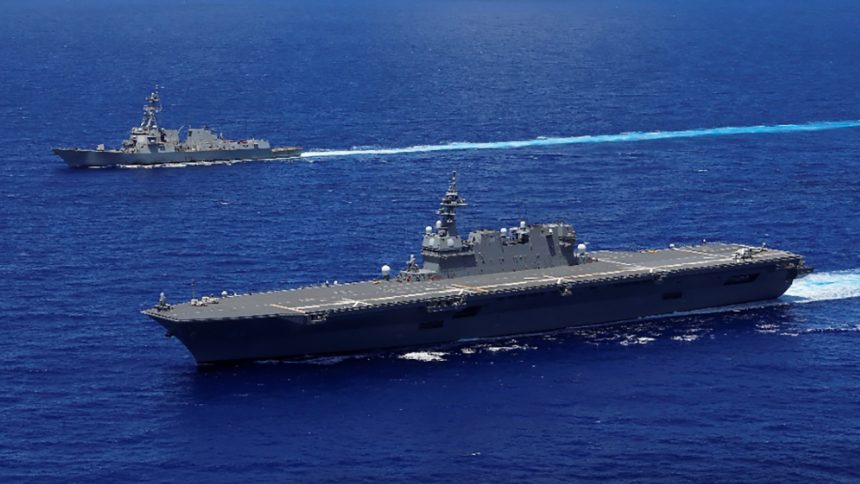The exercise was meant to strengthen cooperation with the U.S. Navy to realize a “Free and Open Indo-Pacific”, as well as improve the tactical capabilities of the JMSDF and JS Izumo, scheduled to operate F-35B Lightning II stealth fighters.
The JMSDF helicopter carrier, JS Izumo, took part in an exercise with the U.S. Navy guided missile destroyer USS Rafael Peralta on Jun. 21, 2024, enhancing tactical interoperability of the two navies.
The bilateral exercise, called Noble Raven 24-2, was held “off the coast of Guam,” according to the JMSDF, and involved only the JS Izumo and the USS Peralta. The drills involved “improving the tactical capabilities of the JMSDF” and “strengthening cooperation” with the U.S. Navy towards realizing a “free and open Indo-Pacific,” according to the statement.
The exercise involved a tactical link exercise (LINKEX), personnel exchanges between the two ships and a photo exercise (PHOTEX). Photos released by the JMSDF showed JS Izumo and the USS Peralta sailing side by side, and an MH-60R naval multirole helicopter being attended to by JMSDF personnel on the Izumo’s flight deck.
Interestingly, JS Izumo is also the same naval vessel that was captured in an unauthorized drone flight by a Chinese citizen at the Yokosuka naval base, whose footage appeared online in March. Beside recording the Izumo, the drone also recorded images of the USS Ronald Reagan aircraft carrier and two other U.S. Navy Aegis destroyers at the base.
F-35B “Lightning Carrier”
The Izumo, along with its sister ship the Kaga, is being prepared for a major change of role and to begin operating as a “Lightning Carrier,” with the conversion works currently in the final stages. The concept envisages using the massive helicopter carrier ship as a vessel carrying only F-35B Lightning II stealth fighters, given their STOVL capability.
#IPD24 第2水上部隊 護衛艦「#いずも」🇯🇵は米海軍 駆逐艦「ラファエル・ペラルタ」🇺🇸と「#自由で開かれたインド太平洋」の実現に向けて連携を強化すべく共同訓練を実施しました。#日米同盟 #トモダチ pic.twitter.com/GIstFMvnFr
— 防衛省 海上自衛隊 (@JMSDF_PAO) June 24, 2024
The need for this conversion emerged amid surging strategic and military tensions with China in the western Pacific, where smaller carriers, logistically easier to operate, can also reduce the burden of larger, full-sized U.S. Navy flat tops. These smaller carriers could provide CAPs (Combat Air Patrols), electronic surveillance and possibly land and anti-ship strike roles, freeing up F/A-18E/F Super Hornets and EA-18G Growlers fighters for other missions.
Also, these carriers could also take aboard the F-35Bs operated by the USMC (US Marine Corps) off the land bases in Japan, which are likely to come under massive Chinese tactical ballistic and cruise missile strikes in case of a conflict.
Part of the larger US Navy’s DMO (Distributed Maritime Operations) concept introduced by former CNO (Chief of Naval Operations) Admiral Mike Gilday, the idea is to spread out the assets, get closer to China and fight inside its A2/AD (Anti-Access/Area Denial) bubble. Beside U.S. and Allied operations, this concept also benefits the JMSDF’s objectives.
“By operating F-35B aircraft from Izumo-class ships, the JMSDF will be able to extend its surveillance and reconnaissance and defensive weapons range by hundreds of miles,” mentioned the U.S. Naval Institute in its proceedings. “The challenges to defending the Self-Defense fleet against aircraft armed with cruise missiles (or hypersonic glide weapons) underscore the need to upgrade the Izumo class to operate the F-35B STOVL aircraft, as the average range of ship-killing missiles is in the hundreds of miles while the average range of defensive ship-launched anti-aircraft and anti-missile missiles is only about 100 miles.”
Building up capabilities before China
Japan had invested in modifying the two helicopter carriers, JS Izumo and JS Kaga, into “Lightning carriers” prior to its defense budgets in 2023. In 2021, the Izumo held the initial F-35B STOVL testing with the help of the USMC, which sent its Japan-based aircraft to conduct flight operations on the ship. Prior to that test, the JS Kaga had received a new bow as a part of the modifications, according to Naval News.
3 OCT, the #JMSDF conducted verification of takeoff and landing of the USMC F-35B to JS #IZUMO.
The JMSDF continues to steadily carry out the necessary modifications to the IZUMO class to acquire the capability to operate the F-35Bs. pic.twitter.com/0gtPNzrxQC
— Japan Maritime Self-Defense Force (@jmsdf_pao_eng) October 5, 2021
Earlier this year, on Apr. 6, the JMSDF released the first images of the Kaga after completing “special modification work” as planned on Mar. 29. “The JMSDF will continue to systematically carry out the necessary modifications to the ‘IZUMO’ class destroyer in order to acquire the operational capability of the F-35B,” said the post. Comparing the images, it can be seen that the Kaga’s flight deck towards the bow is now wider and squared, compared to the Izumo’s.
Tokyo is now awaiting the arrival of the first batch of six F-35Bs by late 2024, Naval News added. Japan is expecting a total of 42 F-35B and 63 F-35A jets as per a $23 billion plan approved by the US in Jul. 2020. The Izumo’s exercises with the American warships meanwhile might be aimed at streamlining and putting in place basic operational, sailing, communications and signaling procedures of the two navies before the fielding of the Japanese F-35Bs.
The first special modification work on the destroyer ”KAGA” was completed as planned on March 29.
The JMSDF will continue to systematically carry out the necessary modifications to the “IZUMO” class destroyer in order to acquire the operational capability of the F-35B. pic.twitter.com/JTaLkjRWu5
— Japan Maritime Self-Defense Force (@jmsdf_pao_eng) April 6, 2024
This will lay the groundwork for common interoperability for combined full-scale exercises, that might see the Izumo and the Kaga sail, accompanied by their destroyers and frigates, with U.S. Navy CSGs (Carrier Strike Groups). On Jun. 21, the JMSDF also received the sixth Mogami-class frigate, the JS Agano, after it finished construction at the Mitsubishi Heavy Industries Maritime Systems shipyard. The new acquisitions and exercises are therefore a gradual step towards acquiring material and tactical capabilities before China.









